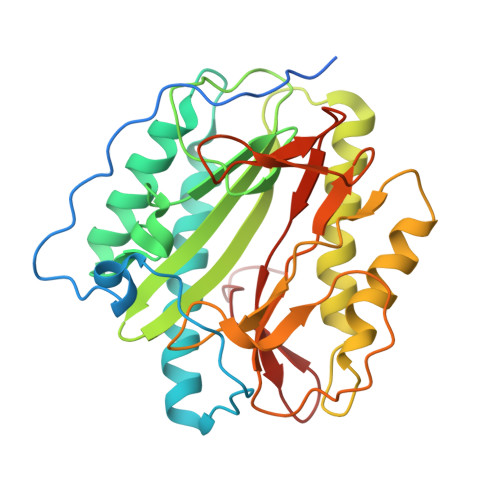Structural insights into N-terminal methionine cleavage by the human mitochondrial methionine aminopeptidase, MetAP1D.
Lee, Y., Kim, H., Lee, E., Hahn, H., Heo, Y., Jang, D.M., Kwak, K., Kim, H.J., Kim, H.S.(2023) Sci Rep 13: 22326-22326
- PubMed: 38102161
- DOI: https://doi.org/10.1038/s41598-023-49332-6
- Primary Citation of Related Structures:
8KHM, 8KHN, 8KHO - PubMed Abstract:
Isozymes are enzymes that catalyze identical biological reactions, yet exhibit slight variations in structures and catalytic efficiency, which enables the precise adjustment of metabolism to fulfill the specific requirements of a particular tissue or stage of development. Methionine aminopeptidase (MetAP) isozymes function a critical role in cleaving N-terminal methionine from nascent proteins to generate functional proteins. In humans, two distinct MetAP types I and II have been identified, with type I further categorized into cytosolic (MetAP1) and mitochondrial (MetAP1D) variants. However, despite extensive structural studies on both bacterial and human cytosolic MetAPs, the structural information remains unavailable for human mitochondrial MetAP. This study was aimed to elucidate the high-resolution structures of human mitochondrial MetAP1D in its apo-, cobalt-, and methionine-bound states. Through a comprehensive analysis of the determined structures and a docking simulation model with mitochondrial substrate peptides, we present mechanistic insights into the cleavage process of the initiator methionine from mitochondrial proteins. Notably, despite the shared features at the active site between the cytosolic and mitochondrial MetAP type I isozymes, we identified distinct structural disparities within the active-site pocket primarily contributed by two specific loops that could play a role in accommodating specific substrates. These structural insights offer a basis for the further exploration of MetAP isozymes as critical players in cellular processes and potential therapeutic applications.
Organizational Affiliation:
Research Institute, National Cancer Center, Goyang, 10408, Republic of Korea.

















